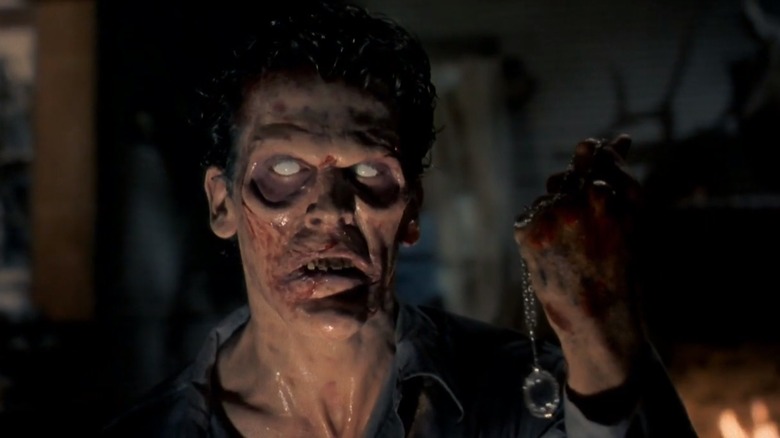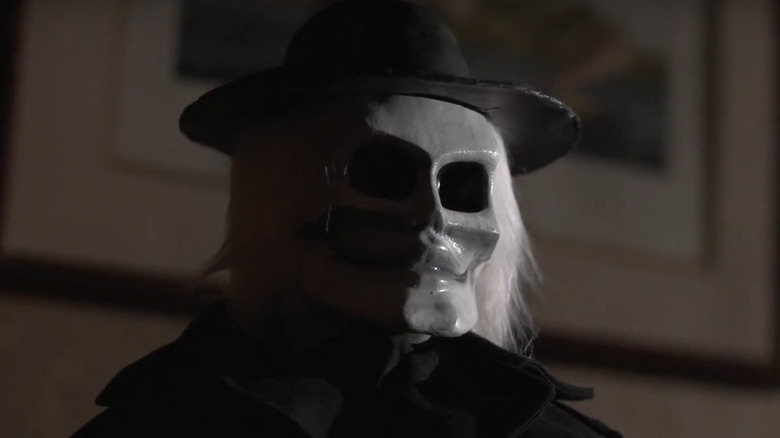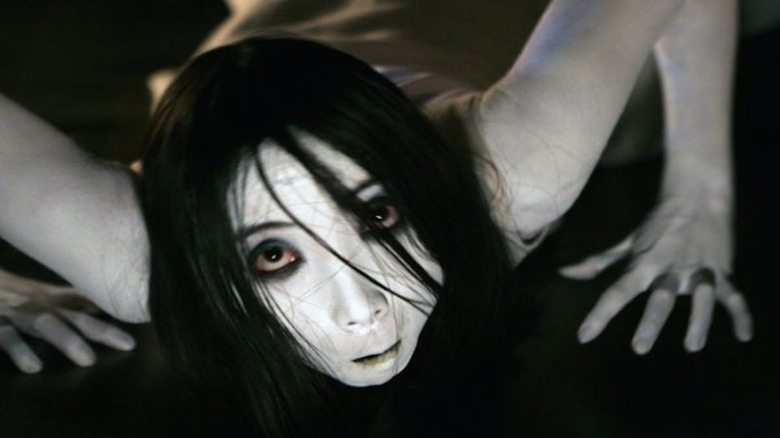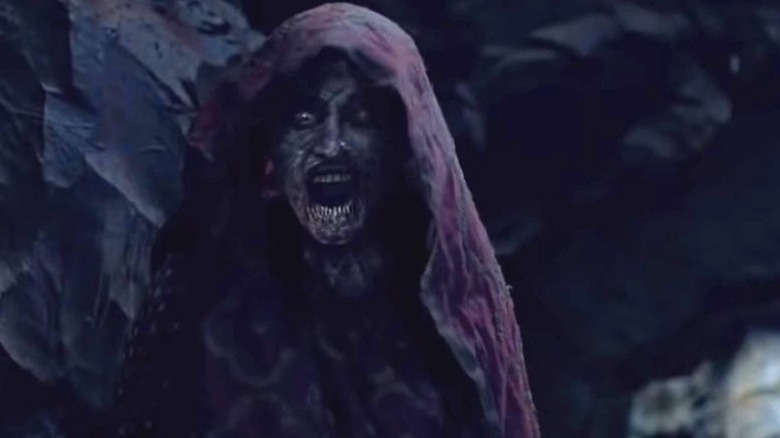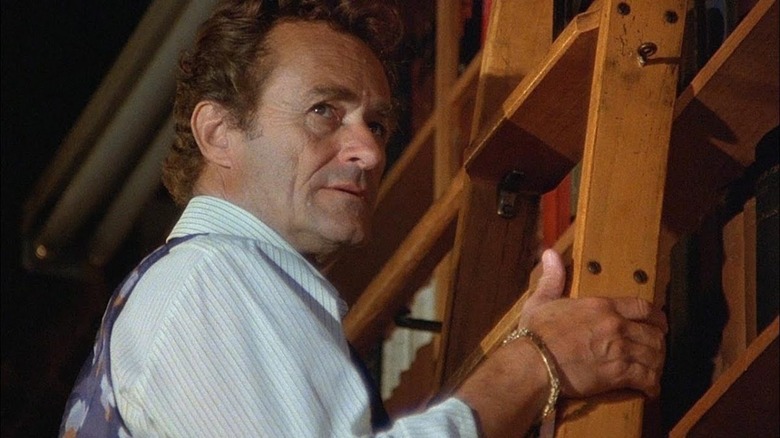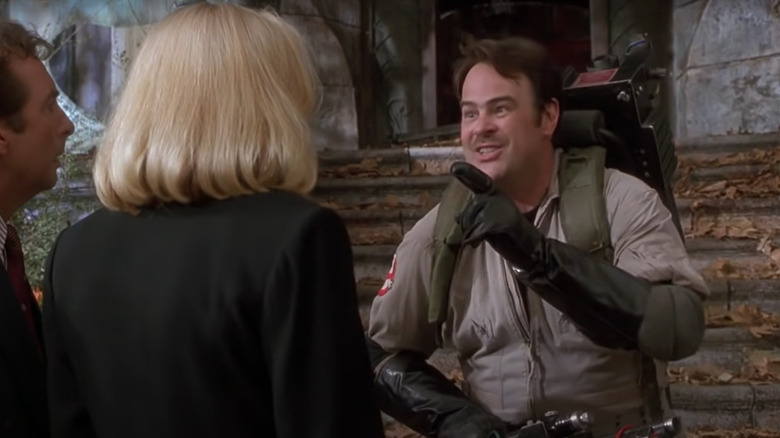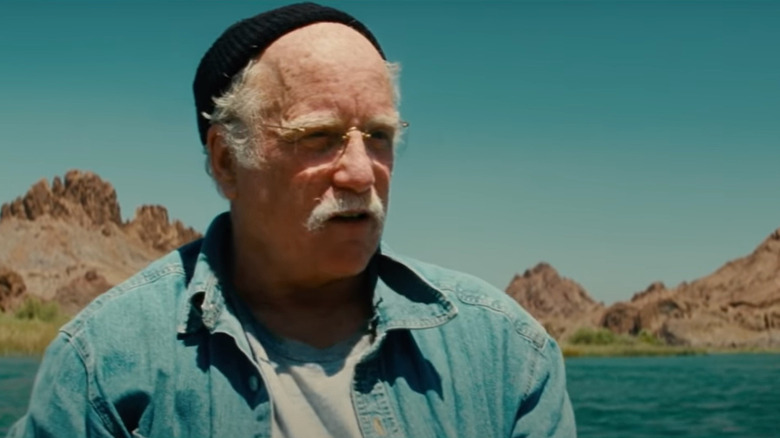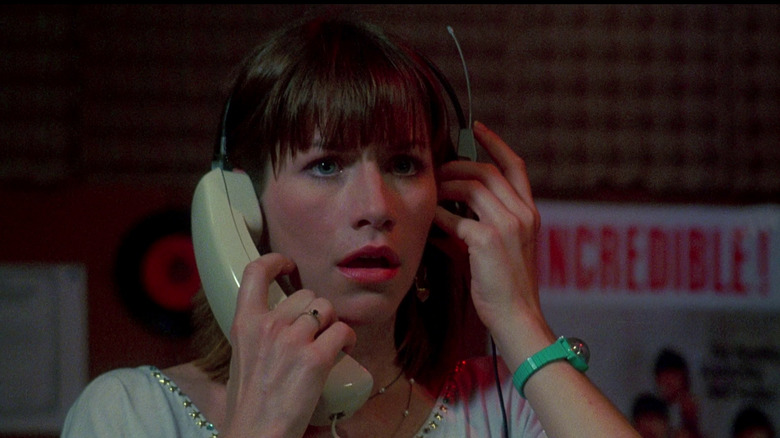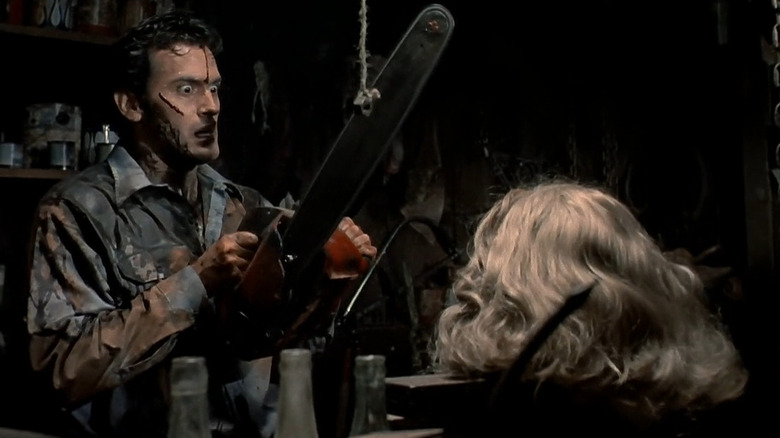Horror Movies You Never Realized Were In The Same Universe
There's no shortage of shared universes in film and television. The Marvel Cinematic Universe (MCU) and the DC Extended Universe (DCEU) are two of the most prominent examples of this connected approach to storytelling, but there are also the Tarantinoverse and Kevin Smith's View Askewniverse among many others that pervade the pop culture landscape (with plenty more on the way). While it can be easy to dismiss the concept of a shared universe as a mere fad, something that the entertainment industry can exploit to squeeze more money out of fans, the truth is that done correctly, shared universes allow for more complex and layered storytelling. Also, shared universes are a ton of fun for audiences. Viewers who've paid close attention to their favorite movies and shows will be rewarded when the small details from one story appear in and even impact another story, setting up the possibility of different characters and worlds coming together later.
With major studios plotting out how their existing properties can be expanded into other stories and media, it's easy to forget that there have been quite a few other shared universes already. Surprisingly, the horror genre has been playing with the idea of having many of its most popular characters existing alongside one another for quite a while — well before the release of such crossover films as "Freddy vs. Jason" and "Alien vs. Predator." If you want a list of the horror movies you never realized were in the same universe, then read on.
Full Moon Features
While Full Moon Features will never be recognized as a purveyor of high-quality cinema, they've nonetheless managed to make quite a few sci-fi, horror, and fantasy films that have attracted cult followings. The company has a passion for killer doll movies, the first of which, 1989's "Puppet Master," spawned numerous sequels, prequels, and spinoffs. It didn't take long for Full Moon to see the limitless potential of basing film premises on small characters, so in 1991, they released "Dollman," a sci-fi flick about a 13-inch tall space cop. 1992 saw the company launch the horror-comedy "Demonic Toys" which differs from "Puppet Master" in that the villains are toys instead of puppets. Full Moon continued with the small character theme in 1992's "Bad Channels," a sci-fi comedy about two aliens who invade a radio station on Earth to use broadcasts to lure women to them and shrink them down to 11 inches tall.
How do these cinematic masterpieces connect? These films first started to cross over with one another in 1993's "Dollman vs. Demonic Toys," which also featured a character from "Bad Channels." 2004's "Puppet Master vs. Demonic Toys" saw the titular titans cause plenty of miniature mayhem. Full Moon has yet to grow out of their pint-sized obsession, as their "Gingerdead Man" series collided with their "Evil Bong" series, resulting in "Gingerdead Man vs. Evil Bong," a film whose genius is so great, it will take humanity decades to fully appreciate.
Sadako vs. Kayako
"Ring" (also known as "Ringu") is a 1998 cinematic adaptation of the 1991 novel by Koji Suzuki. The film follows a reporter who is looking into an urban legend about a videotape haunted by the vengeful spirit of a young girl named Sadako Yamamura that kills anyone seven days after viewing it. Several sequels followed, and there was an American remake, 2002's "The Ring," starring Naomi Watts. "Ju-On" is another long-running Japanese horror film franchise that got its start from a series of novels. The first film in the series was released in 2002 and told the story of a social worker who is plagued by two malevolent spirits (Kayako and her son Toshio) when she visits a home with a violent history. Like "Ringu," "Ju-On" was followed by numerous sequels as well as a big-budget American remake in the form of 2004's "The Grudge," starring Sarah Michelle Gellar.
America isn't the only country that likes to take its film franchises and crash them into one another, as the primary ghosts from both of these Japanese horror series would eventually meet in 2016's "Sadako vs. Kayako." The film follows two college students who, out of curiosity, unleash Sadako's evil spirit and must combat her with another evil spirit — that of Kayako. Response to "Sadako vs. Kayako" from both audiences and critics was lukewarm at best, so don't expect these two ghosts to step into the ring again anytime soon.
Dinesh Vijan's horror-comedy universe
Released in 2018, "Stree" is a frightfully funny take on the Indian legend of Nale Ba that revolves around the ghost of a dead bride who wanders around rural areas in search of her husband. The ghost is reputed to kidnap the random men she encounters, especially those who are the primary breadwinners of their families. It's a pretty horrific myth, but in "Stree," it's given a comedic take. Filmmaker Dinesh Vijan also produced its 2021 spinoff, "Roohi." In this installment, two inept criminals are hired to kidnap a young woman who happens to be possessed by a demonic entity. Things get weird when one of them falls in love with the girl while the other falls in love with the demonic entity. Set to be released in November 2022, the Vijan-produced "Bhediya" will spoof traditional Indian werewolf legends.
Now, it may seem that the only features these films have in common with one another are that they're overseen by Dinesh Vijan and that they're supernatural horror comedies. However, this series of films includes multiple actors reprising their roles (including Flora Saini, Rajkumar Rao, and Abhishek Banerjee) and serving as additional connective tissue between each installment. Several cast members are set to appear in the four additional films that are scheduled to be released starting in 2023.
The Walter Paisley shared universe
The late, great actor Dick Miller has made appearances in countless classic films, including "The Terminator," "Gremlins," "The 'Burbs," and many more. While he rarely played leading roles, his distinctive down-to-Earth demeanor and signature gravelly voice always made welcome additions to any film he graced. However, did you know Dick Miller's character Walter Paisley was the linchpin of a whole cinematic universe that spans decades?
The debut of Miller's Walter was in Roger Corman's 1959 horror-comedy, "A Bucket of Blood," wherein he's a busboy at a pretentious beatnik café who soon attracts acclaim for his statues. His "statues," however, are actually the corpses of people he's murdered and covered in clay. While Walter committed suicide at the end of the film, he apparently recovered and was reprised by Miller in Joe Dante's werewolf satire, "The Howling," as the owner of an occult bookshop. Dante brought Walter back again for his segment in "Twilight Zone: The Movie," which saw him returning to the hospitality business as the owner of a diner where his attempts to flirt with a customer are thwarted by a call from his wife. However, Walter's next appearance is as a janitor in 1986's "Chopping Mall," which follows a group of teenagers who spend the night in a shopping mall with a security detail of a trio of high-tech robots that eventually go on a rampage. Poor Walter gets electrocuted by one of the killer 'bots, but he's died before and gotten over it and would go on to appear in other horror films like "Night of the Creeps" and "Hanukkah."
Ghostbusters and Casper
"Ghostbusters" is a cherished film that has delighted audiences since its release in 1984. The story of four enterprising men who decide to make hunting ghosts into a career is packed with laughs and scares in equal measure and was bolstered by an unstoppable cast that includes Dan Aykroyd, Harold Ramis, Bill Murray, Sigourney Weaver, and Rick Moranis. The film was followed by a direct sequel in 1989, followed by a reboot in 2016, and capped off with 2021's "Ghostbusters: Afterlife." Casper the Friendly Ghost is a character who appeared in countless cartoons from 1945 and on through his big-budget, live-action debut in 1995's "Casper." The film stars Christina Ricci and Bill Pullman as a daughter and father who move into a house that happens to be the home of Casper and his piggish uncles, the Ghostly Trio." "Casper" was popular enough to warrant two additional installments: 1997's "Casper: A Spirited Beginning" and 1998's "Casper Meets Wendy."
However, these two franchises have more in common than simply being lighthearted movies about ghosts (although "Casper" is darker than you might think): Dan Aykroyd makes a cameo appearance in "Casper" as Ray Stantz from "Ghostbusters" during a sequence in which the heiress of the haunted house calls on several experts to rid it of its ghostly inhabitants. Stantz even references the classic Ray Parker Jr. song when, after failing to bust some ghosts, says, "Who you gonna call? Someone else!"
Jaws and Piranha 3D
"Jaws" is a landmark film for several reasons: It was Steven Spielberg's first big success, it launched the concept of the summer blockbuster, and its theme (composed by the legendary John Williams) is one of the most iconic in cinema history. The movie was such a hit that it led to three sequels, none of which lived up to the greatness of the original. Like many trendsetting movies, "Jaws" inspired a host of other "animals attack innocent people" movies. While most of these films were cheap imitations, the best of the lot is Joe Dante's 1978 film, "Piranha," as it treated the concept with a sly sense of humor that still holds up well today. It was even loosely remade in 2010 as "Piranha 3D" by horror director Alexandre Aja.
The through-line that joins the world of "Jaws" to that of "Piranha 3D" is Academy Award-winning actor Richard Dreyfuss, who played oceanographer Matt Hooper in the former and reprised the character in the latter. While Dreyfuss may be credited as "Matt Boyd" in "Piranha 3D," the actor confirmed who he was really playing in an interview with Hollywood News, saying, "I play Matt Hooper. I play the older Matt Hooper, who escaped being eaten by the shark and is now eaten by a bunch of piranha fish." It's a nasty end for the character, but at least the actor's payment was a donation to his civics education project, The Dreyfuss Initiative.
The Texas Chainsaw Massacre 2 and Sharknado: The 4th Awakens
"The Texas Chain Saw Massacre" is a horror classic that spawned a whole slew of gory sequels, prequels, spinoffs, reboots, and remakes. Its first sequel, "The Texas Chainsaw Massacre 2," was released in 1986 and largely veers away from the snuff film aesthetics of the original, instead going down a more darkly comedic path. The film focuses on Caroline Williams' character Vanita "Stretch" Brock, a radio DJ who gets caught up in a plot to lure the killers from the previous film out of hiding. "Sharknado" is a series about shivers of sharks that arrive in major metropolitan areas via tornados and eat people. It's a simple premise, but the sheer wackiness of it has nonetheless found a consistent audience and has led to multiple sequels and even a spinoff franchise in "Lavalantula."
There may not be a clear connection between chainsaws and sharks, which is why we need to look at actress Caroline Williams and her character, Stretch. Stretch is most famous for her part in "The Texas Chainsaw Massacre" (as well as a brief appearance in "Leatherface: Texas Chainsaw Massacre III), but Williams did reprise the character in 2016's "Sharknado: The 4th Awakens," this time as the owner of a chainsaw store. She made a great DJ, but after confronting Leatherface, it makes sense for her to switch careers to something a little more relevant to her experience.
The Evil Dead, Friday the 13th, and Pumpkinhead
The Necronomicon is the creation of influential early-20th century horror author H.P. Lovecraft. An ancient grimoire of horrible spells, the Necronomicon would later be used by countless other horror authors and even make appearances in cinema. A version of the book called the Necronomicon Ex-Mortis plays a major role in the "Evil Dead" films and was said to deal with "demons and demon resurrection and those forces which roam the forest and dark bowers of man's domain." Of course, when a group of young people decides to have some fun with it, they accidentally awaken an eldritch and malevolent force that terrorizes its victims across three movies.
However, this version of the Necronomicon wasn't just confined to the "Evil Dead" series, as it would later appear in 1993's "Jason Goes to Hell: The Final Friday," seemingly implying that Jason Voorhees' resurrection may have gotten an assist from the book. It would also go on to make another appearance in 1994's "Pumpkinhead II: Blood Wings," in which it was seen in the house of the old witch. It makes perfect sense for the Necronomicon Ex-Mortis to show up in movies that involve bridging the gap between the living and the dead, but that would also mean that the tome's owners also check it out from the same library. (Bonus connections: Freddy Kreuger's glove can be seen in the background in "Evil Dead 2," although this is more of a callback to when Wes Craven had "The Evil Dead" playing on a TV in "A Nightmare on Elm Street.")
Behind the Mask: The Rise of Leslie Vernon, Black Christmas, and more
Considered one of the greatest slasher films ever, "Behind the Mask: The Rise of Leslie Vernon" is a mockumentary horror satire that takes place in a reality wherein the killers behind slasher flicks are real-life historical figures. Inspired by their kill counts, Leslie Vernon (Nathan Baesel) is an aspiring serial killer who wishes to join the ranks of these infamous supernatural killers but must use ordinary means to do so because of his lack of otherworldly abilities. Documenting Leslie's path to gory glory are journalist Taylor Gentry (Angela Goethals) and a couple of cameramen, who watch Leslie plan each murder with meticulous detail and even meet his mentor Eugene (Scott Wilson), a retired killer from the good ol' days.
It's heavily implied that Eugene is Billy from 1974's "Black Christmas." While the characters have different names and are played by different actors, "Behind the Mask" screenwriter David J. Stieve confirmed the connection to Bloody Disgusting, saying, "I can confirm that Eugene has always been Billy in my mind ... It always fit for me that Eugene would have that 'old school' nostalgia and slight professional jealousy that even though he was a pioneer in the business of fear, he never achieved the fame or notoriety of his successors." The film also makes quite clear that the killers who Leslie looks up to are Jason Voorhees from the "Friday the 13th" franchise, Freddy Krueger from the "Nightmare on Elm Street" films, and Chucky from the "Child's Play" films. Speaking of those guys ...
Friday the 13th, A Nightmare on Elm Street, Child's Play, Texas Chainsaw Massacre, and Halloween
"Behind the Mask: The Rise of Leslie Vernon" wasn't the first film to imply that cinema's biggest baddies all existed in the same universe. Those seeds were planted years earlier. The ending of 1993's "Jason Goes to Hell: The Final Friday" sees the bladed hand of Freddy Kreuger (Robert Englund) exploding out of the ground to presumably take Jason Voorhees' (Kane Hodder) mask to hell. While that little tease would ultimately pay off in 2003's "Freddy vs. Jason," the connections between those two villains were established in 1998's "Bride of Chucky" in a scene that features a police storage locker that just happens to have Freddy's glove and Jason's hockey mask.
But wait, there's more! Also seen in that police storage locker are the mask of Michael Myers (from the "Halloween" series) and Leatherface's chainsaw. This scene opens up countless possibilities of a wider shared universe that's far more sprawling than we might realize. For example, if the Necronomicon Ex-Mortis from the "Evil Dead" franchise exists in the "Friday the 13th" franchise as we previously established, then that means it also exists in the "Child's Play," "Nightmare on Elm Street," and "Texas Chainsaw Massacre" franchises as well! Heck, maybe the chainsaw Ash uses to replace his hand was purchased from Stretch. Think about it!
